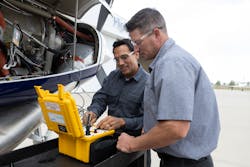Troubleshooting is a Skill to Master
Highly skilled maintenance technicians continually need to discover the answer and formulate plans to address the problem or ways to prevent it from happening in the first place.
Troubleshooting on aircraft and components is a process that requires repeating thoughts and actions until it’s fully addressed. This iterative process begins with identifying the problem, then taking a linear approach to the situation in a scientific, but intuitive fashion:
- Collecting and analyzing data
- Determining possible causes
- Formulating best options and approaches
- Testing and verifying those options
- Taking corrective action
- Repeating if necessary
Even without a prescribed checklist, we all do some form of troubleshooting daily in nearly everything we do. If we are driving a specific destination, for example, we make adjustments based on split-second data from other cars on the road, keeping their independent and perhaps erratic, driving in mind to avoid collisions or stay within the flow of traffic. Maybe we identify a speed trap upcoming by sighting a police officer on the side of the road. On a larger scale, we take the input of construction work, road closures or traffic bottlenecks, to alter our familiar routes or create a better, data-driven path to where we need to go, more actively troubleshooting and reacting.
Aircraft troubleshooting works in a similar fashion, just with more systems to monitor and learn. But just like your reactions on the road, the end goal for all aircraft troubleshooting is helping to make sure everyone gets to their destination safely.
An Approach to Aircraft Troubleshooting
FlightSafety employs a four-step process in training technicians to troubleshoot:
- Define the situation
- Find the paths of influence (inputs-outputs)
- Test (find unsatisfactory input-output)
- Take corrective action or repeat
It’s key to be able to use a process that can be repeated over and over until a resolution is found. The ability to clearly define the paths of influence by isolating what’s normal and what’s abnormal is critical.
FlightSafety trains to document those paths of influence and then make the decision on how to test the inputs and outputs. What are the signs of data to be collected – a light, a message, a noise, a smell or something else? What type of test equipment is needed such as volt/ohm meter, megger, temp sensor, pressure gauge, test box, etc.?
Understanding what the test actually does is also important. Depending on the test and the test equipment it may be necessary to isolate the circuit or system to prevent inadvertent damage. Clearly defining the situation and the paths of influence are important and most find documenting very helpful.
At times, the division of the system or circuit will be dictated by location and access of the identified test points. Even when an issue is isolated down to a component, one might not be able to be 100% confident, but it is as close as we can get.
A significant amount of troubleshooting starts with the controls and indicators on the flight deck, so again being familiar with normal systems operation is critical. With many of today’s aircraft, utilization of centralized maintenance computer (CMC) or other onboard maintenance systems (OMS) is an integral part of effective troubleshooting. Depending on the particular CMC/OMS, many now have capabilities that even allow us to test the identified path.
Practice and Implementation
Just like flying an aircraft or driving a car, troubleshooting is a learned skill that improves with practice. And just like driving, we can become complacent with minimal troubleshooting – imagine the driver who “knows” the route like the back of their hand, but fails to adjust to new data inputs like a stalled car impeding progress on the familiar path. In aircraft, minimal troubleshooting leads to increased downtime, unnecessary expenses and reduced safety margins.
Successful troubleshooting puts safety as the top priority. That means knowing how systems and parts are supposed to work and identifying the issues before they become larger problems. Troubleshooting is a trainable skill, but also one that can be improved and mastered.

